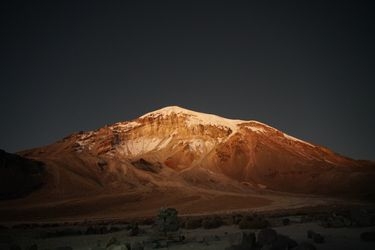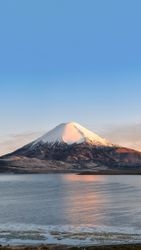Climbing Huayna Potosi





Huayna Potosi is a striking peak located in Bolivia, standing at an impressive height of 6,088 meters (19,974 feet). It's a mountain that offers a classic Andean climbing experience, with its white, glacier-covered summit visible from the city of La Paz. The climb is often described as accessible for those with basic mountaineering skills, yet still challenging enough to provide a rewarding experience. The ascent typically involves traversing glaciers, negotiating crevasse zones, and a final push up a steep summit ridge, which can test your endurance and technical abilities.
The climb of Huayna Potosi is usually approached from Zongo Pass, where climbers acclimatize at the base camp before making their way to the high camp. The conditions on the mountain can vary significantly with weather, but generally, the best time for an attempt is during the dry season from May to September. This is when the route is most stable, with firm snow and reduced avalanche risk. The ascent demands a start in the early hours, with a typical summit day requiring a 6-10 hour round trip, depending on conditions and individual pace.
Technical sections on Huayna Potosi are relatively straightforward by high-altitude climbing standards, but they require proficiency in using crampons and an ice axe, as well as the ability to navigate glaciated terrain. Even for experienced mountaineers, acclimatization is crucial given the altitude and the potential for altitude sickness. It's a mountain that combines the allure of high-altitude climbing with breathtaking vistas over the Cordillera Real. There are currently 5 guides that offer expeditions up Huayna Potosi, providing opportunities for those looking to embark on this Andean adventure.
Table of contents
Difficulty
- PD: Not very hard (alpine grade 2)
When to go
- June to August
Permits
- 1 permit is needed
- costing around $7 total
These are pictures taken while climbing Huayna Potosi. They're shown here to give you an idea of what the route is like. You're welcome to share your own pictures of climbing Huayna Potosi, to help the community of climbers. Picture here are either uploaded by members (their own, or creative commons pictures), or guides.
Guide links
Huayna Potosi History
Climbing history of Huayna Potosi
The history of Huayna Potosi is as rugged and compelling as the mountain itself. Early summit attempts date back to the early 20th century, with the first recorded successful ascent made by German climbers Rudolf Dienst and Adolf Schulze in 1919. Their pioneering spirit paved the way for future adventurers drawn to the allure of Huayna Potosi's challenging peaks.
The region surrounding Huayna Potosi is home to indigenous Aymara communities, whose rich cultural heritage and deep connection to the land add an intriguing layer to the mountain's history. Their traditions and knowledge of the area have been instrumental for climbers seeking to understand and navigate the formidable terrain.
 Base Camp
Base Camp
 High Camp
High Camp
 Summit
Summit
You can drive straight to base camp, staying there is optional. From there it's a three hour walk up to high camp on decent paths without snow/ice. From high camp (the refuge) it's 4-6+ hours to the summit, all on snow. Alternatively there's the 'French route' which breaks off from the main trail an hour or so after high camp and goes up to a lower summit (traversing to the main summit is possible, but not typical).
Huayna Potosi Services
Gear rental, porters, guides, transport, internet, accommodation
Accommodation
There is both a base camp and high camp refuge. Multiple at each camp. Base camp is of course nicer, high camp is one big dorm.Food
You can get food at both base camp and high camps, but generally at high camps the kitchens are used by guides for their groups, and you'll need to bring your own food.Guides
There are infinite guides for this route.Porters
Porters are available.Huayna Potosi permits
What permits are needed for climbing Huayna Potosi
1. National Park Entrance Fee
- $7 (~50 in the local currency)
- This fee grants access to the national park where Huayna Potosí is located.
- Can be purchased locally just before reaching the base camp.
Huayna Potosi access - getting there
How to get to Huayna Potosi
Huayna Potosi questions
What to know about climbing Huayna Potosi
Common questions people have about this trek, if yours isn’t here - add it to get an answer.
Huayna Potosi Links
useful websites, Groups and communities
Groups / links with more info on the Huayna Potosi route.
These climbs are similar in length, difficulty, and elevation. Offering a similar level of challenge as the Huayna Potosi climb.






